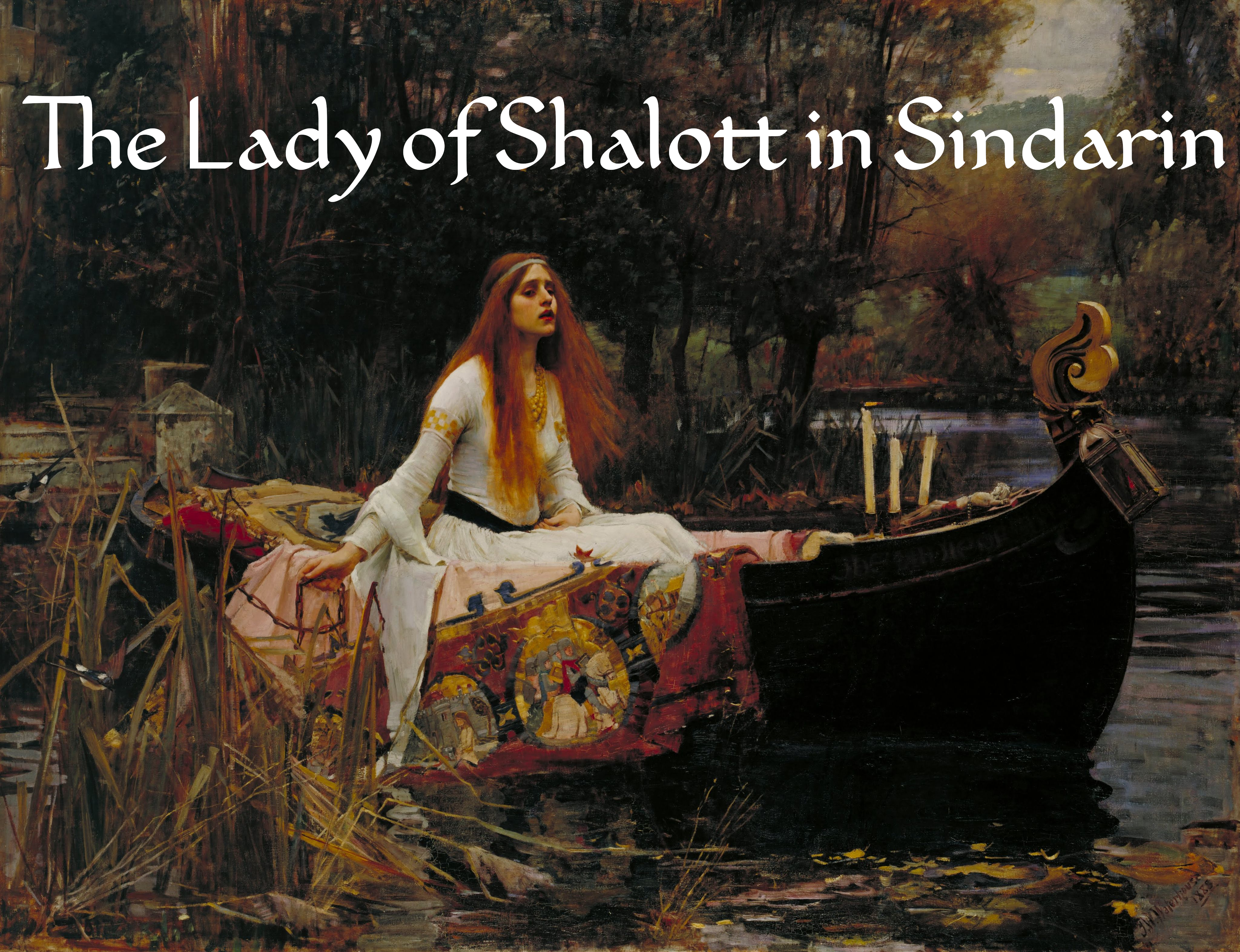
Original poem: The Lady of Shalott by Lord Alfred Tennyson.
Translated into Sindarin by Fiona Jallings
Painting by John William Waterhouse
Part 1
| Sindarin | Literal English | Original English |
|---|---|---|
| Bo ath-rant dorthar breniel rídhien1 i-thair theriel, Hammar dawar, govenir ell2; A thrî rîdh i ven hiriel Am marad Camelod; Adh in gwaith dadwen a dandol, Tired had i-ningloer lodol Nu-din os dol, I dol Salod3. |
On either side of the river they dwell lasting Great fields of the thriving grasses, They clothe woods, they meet the sky; And through fields the road flowing To the fortress of Camelot; And the peoples go back and forth Seeing a place of water-lilies floating Beneath them around an island, The island of Shalott. |
On either side the river lie Long fields of barley and of rye, That clothe the wold and meet the sky; And through the field the road runs by To many-towered Camelot; And up and down the people go, Gazing where the lilies blow Round an island there below, The island of Shalott. |
| Yrn girir, tethair nimmidar, Hwist dithin hwiniar a thuiar Trî i ‘ôl4 i ui-hiriar min hirion a thol na char Rimmad an Gamelod. Canad raim a beraid vithrin Orthirir i had-i-phirin, Adh i dol dhínen baugla dhîn I chiril os Salod. |
Trees quiver, willows whiten, Quiet breezes twirl and blow Through the wave that flows forever In the great river with the island with a building Flowing to Camelot. Four grey walls and towers, Overlook the place of the winking flowers. And the silent isle oppresses silently The lady of Shalott. |
Willows whiten, aspens quiver, Little breezes dusk and shiver Through the wave that runs for ever By the island in the river Flowing down to Camelot. Four grey walls, and four grey towers, Overlook a space of flowers, And the silent isle imbowers The Lady of Shalott. |
| Anin hîr, dathar-‘wathrannen, I lynt lyng pennar aphannen Ad lebyr; adh ú-huilonen Lunt lodant nan ram ídhannen Lodad dad an Gamelod Ach va idír i huiloneth5? Egor den idír na chenneth? Egor the hinnen min ndorath, I chiril os Salod? |
To the river, willow-veiled, The heavy boat slants downwards followed By horses; and not greeted A boat floated with a desirable sail Floating down to Camelot: But who saw the greeter? Or saw her at the window? Or is she known in all the lands, The lady of Shalott? |
By the margin, willow-veiled, Slide the heavy barges trailed By slow horses; and unhailed The shallop flitteth silken-sailed Skimming down to Camelot: But who hath seen her wave her hand? Or at the casement seen her stand? Or is she known in all the land, The Lady of Shalott? |
| Crithoer, crithad ne minuial, Mi faing iaw apharch orchal Lastar ‘laer veren lend iallol Od i hirion hwiniol, Dad ani meraid Camelod: Nuin galad Ithil, i grithor brastol ‘othair mi thynd na-nadhor, Lastol pêd “Elleth e-ninglor, I chiril os Salod.” |
Reapers, reaping in morning, In the beards of dry, tall corn Hears a festive, sweet song calling From the great spinning river, Down to the towers of Camelot: Under the light of the Moon, the reaper Carrying bundles of grass in the hills with fields, Listening, he says, “The Elf-maid of the water lilies, The Lady of Shalott.” |
Only reapers, reaping early In among the bearded barley, Hear a song that echoes cheerly From the river winding clearly, Down to towered Camelot: And by the moon the reaper weary, Piling sheaves in uplands airy, Listening, whispers “‘Tis the fairy Lady of Shalott.” |
Part 2 to come…
Translation Notes
It was difficult, but I managed to make all of the lines either four or eight syllables long, so you can sing along with Loreena Mckennett in Sindarin.
I used Sindarin in the style of Doriath. It gives the translation an archaic feel.
Reconstructions
- 1. rídhien
- “Great Fields” from “fields-vast/great/wide” (rîdh+iend).
- 2. ell
- “Sky” from Tolkien’s earlier version of Doriathrin (gell) under the root ƷEL.
- 3. Salod, Camelod, Lanselod
- Some of you may be curious why I wrote “Salod” for “Shalott” and “Camelod” for “Camelot” and “Lanselod” for “Lancelot” in the translation. I was simply translating the words into Sindarin phonology. Sindarin doesn’t have the “SH” sound, and P’s, T’s, and C’s directly following a vowel at the end or within a word must become B’s, D’s, or G’s.
- 4. gôl
- “Wave” from Telerin (vola).
- 5. suiloneth
- “Greeter” (suil+oneth) modeled after “bread-giver” (bassoneth).
